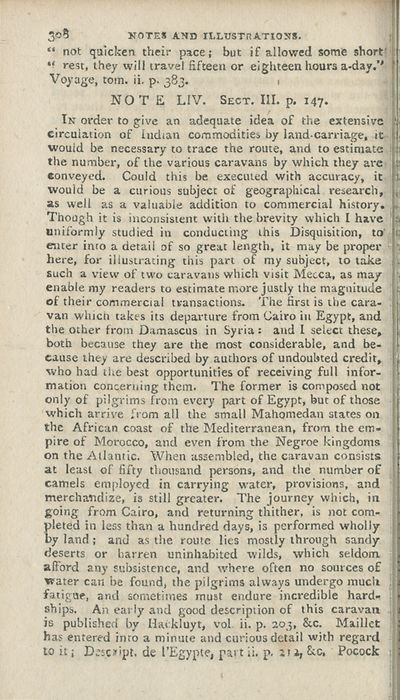Occupations > Historical disquisition concerning the knowledge which the ancients had of India; and the progress of trade with that country
(322)
Download files
Complete book:
Individual page:
Thumbnail gallery: Grid view | List view

3«>3 NOTE! AND HiLUSTnATIONS.
“ not quicken their pace; but if allowed some short'
“ rest, they will travel fifteen or eighteen hours a-day.’*
Voyage, tom. ii. p. 383.
NOT E LIV. Sect. III. p. 147.
In order to give an adequate idea of the extensive |
circulation of Indian commodities by land-carriage, it
would be necessary to trace the route, and to estimate
the number, of the various caravans by which they are
conveyed. Could this be executed with accuracy, it
would be a curious subject of geographical research, j
as well as a valuable addition to commercial history. ,
Though it is inconsistent with the brevity which I have '
uniformly studied in conducting this Disquisition, to'
enter into a detail of so great length, it may be proper ■
here, for illustrating this part of my subject, to take
such a view of two caravans which visit Mecca, as may
enable my readers to estimate more justly the magnitude
of their commercial transactions. The first is the cara¬
van which takes its departure from Cairo in Egypt, and
the other from Damascus in Syria : and I select these,
both because they are the most considerable, and be¬
cause they are described by authors of undoubted credit, i
who had the best opportunities of receiving full infor¬
mation concerning them. The former is composed not
only of pilgrims from every part of Egypt, but of those
which arrive from all the small Mahomedan states on
the African coast of the Mediterranean, from the em¬
pire of Morocco, and even from the Negroe kingdoms
on the Atlantic. When assembled, the caravan consists
at least of fifty thousand persons, and the number of
camels employed in carrying water, provisions, and
merchandize, is still greater. The journey whicb, in
going from Cairo, and returning thither, is not com- j
pleted in less than a hundred days, is performed wholly i
by land; and as the route lies mostly through sandy
deserts or barren uninhabited wilds, which seldom,
afford any subsistence, and where often no sources of
water can be found, the pilgrims always undergo much
fatigue, and sometimes must endure incredible hard¬
ships. An early and good description of this caravan
is published by Hackluyt, vol ii. p. 203, &c. Maillet
has entered into a minute and curious detail with regard j
to it; D;sc»ipt. de I'Egypte, part ii, p. 212, &c, Pocock
“ not quicken their pace; but if allowed some short'
“ rest, they will travel fifteen or eighteen hours a-day.’*
Voyage, tom. ii. p. 383.
NOT E LIV. Sect. III. p. 147.
In order to give an adequate idea of the extensive |
circulation of Indian commodities by land-carriage, it
would be necessary to trace the route, and to estimate
the number, of the various caravans by which they are
conveyed. Could this be executed with accuracy, it
would be a curious subject of geographical research, j
as well as a valuable addition to commercial history. ,
Though it is inconsistent with the brevity which I have '
uniformly studied in conducting this Disquisition, to'
enter into a detail of so great length, it may be proper ■
here, for illustrating this part of my subject, to take
such a view of two caravans which visit Mecca, as may
enable my readers to estimate more justly the magnitude
of their commercial transactions. The first is the cara¬
van which takes its departure from Cairo in Egypt, and
the other from Damascus in Syria : and I select these,
both because they are the most considerable, and be¬
cause they are described by authors of undoubted credit, i
who had the best opportunities of receiving full infor¬
mation concerning them. The former is composed not
only of pilgrims from every part of Egypt, but of those
which arrive from all the small Mahomedan states on
the African coast of the Mediterranean, from the em¬
pire of Morocco, and even from the Negroe kingdoms
on the Atlantic. When assembled, the caravan consists
at least of fifty thousand persons, and the number of
camels employed in carrying water, provisions, and
merchandize, is still greater. The journey whicb, in
going from Cairo, and returning thither, is not com- j
pleted in less than a hundred days, is performed wholly i
by land; and as the route lies mostly through sandy
deserts or barren uninhabited wilds, which seldom,
afford any subsistence, and where often no sources of
water can be found, the pilgrims always undergo much
fatigue, and sometimes must endure incredible hard¬
ships. An early and good description of this caravan
is published by Hackluyt, vol ii. p. 203, &c. Maillet
has entered into a minute and curious detail with regard j
to it; D;sc»ipt. de I'Egypte, part ii, p. 212, &c, Pocock
Set display mode to:
![]() Universal Viewer |
Universal Viewer | ![]() Mirador |
Large image | Transcription
Mirador |
Large image | Transcription
| Antiquarian books of Scotland > Occupations > Historical disquisition concerning the knowledge which the ancients had of India; and the progress of trade with that country > (322) |
|---|
| Permanent URL | https://digital.nls.uk/125579637 |
|---|
| Description | Thousands of printed books from the Antiquarian Books of Scotland collection which dates from 1641 to the 1980s. The collection consists of 14,800 books which were published in Scotland or have a Scottish connection, e.g. through the author, printer or owner. Subjects covered include sport, education, diseases, adventure, occupations, Jacobites, politics and religion. Among the 29 languages represented are English, Gaelic, Italian, French, Russian and Swedish. |
|---|

